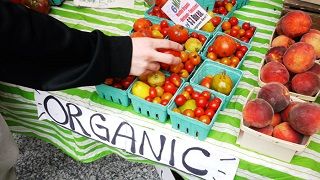From Guest Blogger Tina Samuels: Time for an Organic Garden at Home?
The green movement has produced more gardeners than ever before.
People wanting to have rich delicious fruits and vegetables from their backyard instead of pesticide-ladened ones from the grocery have made a beeline to begin their gardens.
There are many benefits to having an organic garden, here are just a few of them.
What is Organic Gardening?
Organic gardening just means that it develops naturally, without synthetic chemicals like fertilizers and pesticides. This is a natural development of the vegetable or fruit, the way that it was meant to be.
While this means smaller produce due to the limitations of growing without a growth medium like fertilizer, it also means less chemicals to ingest as a result of said fertilizer and pesticide.
Benefits of Organic Gardening
• It is just better tasting. This is because you are eating nothing but the food, not the chemicals that have been put on the food or been put into the soil where the food was grown.
• Organic gardening has tons more of their essential nutrients. There have been University of Washington studies that show that children that have organic food have six times less pesticide levels than those that do not have that type of diet.
• Gardening is a great form of exercise, and you’ll be doing more of it when you’re weeding and plucking off dead parts of the plant, etc, that usually is done by the chemicals during the process. As you are “working” more, you are burning more calories and warding off medical conditions such as stroke, heart disease, type 2 diabetes, and high blood pressure.
Getting Started with Organic Gardening
There is an easy way to get started with the basics of organic gardening.
• Step One – Get the Soil in Tune. You want to make sure that your soil is quality, so get it tested that tells you the nutrient levels and the pH factor of the soil. It should also be rich in humus, that nice organic matter that gardeners adore. If you need to alter the soil, do so with organic compost and manure.
• Step Two – Get the Right Plants for the Garden. You want to make sure your plants are for your hardiness zone and for the pH factor that you found out your soil is. Get plants that have not been sprayed prior, or grow from seed. Plant these in a wider bed than normal so that you have the ability to group them tight together and not be able to walk on them. Tight planting reduces the need for weeding.
• Step Three – Water and Weeding. You want to water these plants in the morning when it is cooler. This allows them to absorb better without the sun burning off the water and evaporating. Weeding should be done preferably by hand so that you can get more of them. Mulching around the plants can help stave off weeds.
• Step Four – Harvest. After they ripen, harvest them quickly.
As you can see, there are far more nutrients and benefits to good organic foods than those that have been grown far away and with chemicals.
Having your family eat healthier, plus the bonding that can occur during the planting and harvesting, can really help keep happiness in the home.
About the Author: Tina Samuels writes on billfloat, social media, home improvements, gardening, health, and small business.

